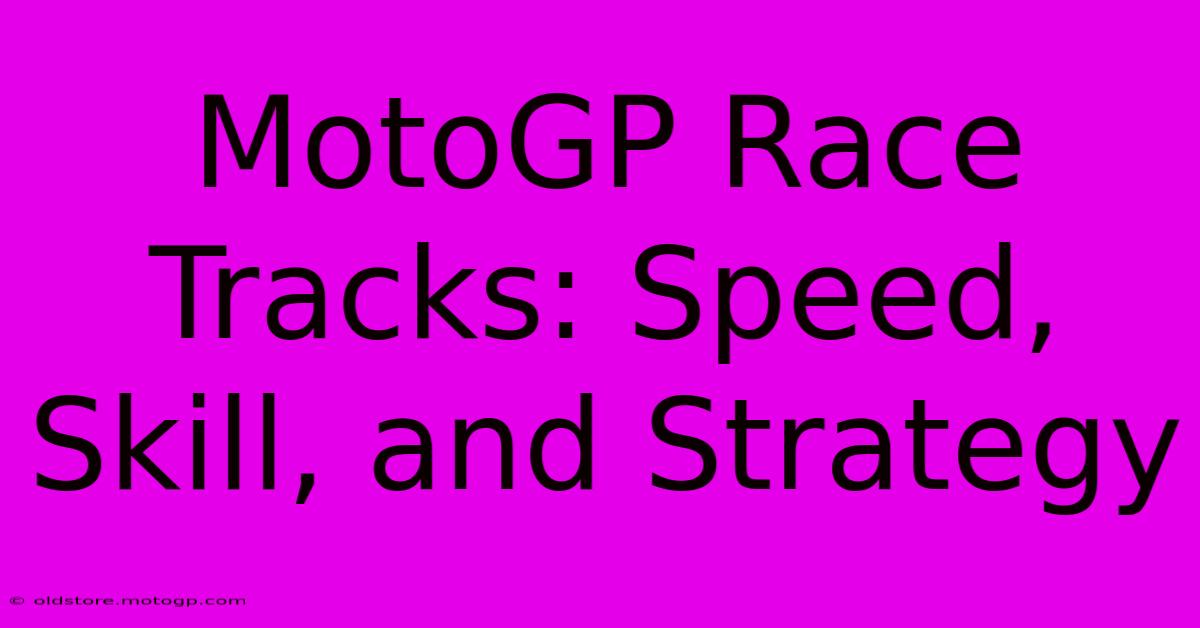MotoGP Race Tracks: Speed, Skill, And Strategy

Table of Contents
MotoGP Race Tracks: Speed, Skill, and Strategy
The roar of the engines, the smell of burning rubber, the breathtaking speeds – MotoGP is a spectacle of skill, precision, and raw power. But the drama isn't just on the track; it's deeply intertwined with the unique characteristics of each race circuit. These aren't just asphalt ribbons; they're demanding battlegrounds where strategy and rider skill are tested to their absolute limits. This article delves into the world of MotoGP race tracks, exploring how their design impacts the race, and the strategic considerations riders and teams must make.
The Anatomy of a MotoGP Track: More Than Just Turns
MotoGP tracks aren't simply a collection of corners; they're carefully engineered combinations of straights, chicanes, and various corner types – each demanding different skills and techniques. Understanding these elements is crucial to understanding the race itself.
High-Speed Sections:
These long, sweeping straights are where MotoGP bikes truly showcase their power. Tracks like the Motegi Circuit in Japan and the Autodromo Internazionale del Mugello in Italy boast incredibly long straights, making top speed and aerodynamic efficiency critical. Here, slipstreaming – drafting closely behind another bike to reduce air resistance – becomes a vital tactical tool. Riders must judge the optimal moment to overtake, balancing the risk of losing speed against the potential gains.
Technical Sections:
In contrast to the high-speed sections, technical sections are characterized by a series of tight, challenging corners. The Circuit de Barcelona-Catalunya in Spain and the Red Bull Ring in Austria are prime examples. These sections demand precise throttle control, impeccable braking, and flawless line selection. Riders must navigate these sections with incredible finesse, minimizing time lost while maintaining stability and control. These sections often separate the truly skilled from the rest of the pack.
Elevation Changes:
Some tracks incorporate significant elevation changes, adding another layer of complexity. The Circuit de Jerez in Spain and the Buriram Circuit in Thailand feature undulating terrain, demanding significant bike control and rider fitness. These elevation changes impact acceleration, braking, and cornering, requiring riders to adapt their riding style throughout the lap.
Strategy: The Unsung Hero of MotoGP Racing
The track layout directly influences the racing strategy. Teams meticulously analyze every detail, from the ideal braking points to the best overtaking opportunities. This analysis dictates tire choice, fuel load, and engine settings.
Tire Selection:
Different tracks demand different tire compounds. High-speed tracks necessitate tires that provide excellent stability at high speeds, while technical tracks require tires with superior grip in corners. The choice of front and rear tire compounds is crucial and can significantly impact race performance.
Fuel Strategy:
Fuel consumption varies greatly depending on the track layout. Long, fast straights consume more fuel, requiring careful planning of fuel loads to complete the race. Teams must balance fuel efficiency with maximizing lap times, often making strategic decisions about the fuel load to optimize race pace.
Overtaking Maneuvers:
The opportunities for overtaking are determined by the track’s characteristics. Tracks with long straights and good braking zones offer more overtaking opportunities, leading to more aggressive racing. In contrast, tracks with tight, technical sections provide fewer opportunities, potentially resulting in more controlled and strategic races.
Conclusion: A Symphony of Speed and Strategy
MotoGP race tracks are more than just circuits; they are the ultimate test of rider skill, machine performance, and strategic acumen. The unique characteristics of each track – high-speed straights, technical sections, and elevation changes – demand adaptability and precision. Understanding these elements allows for a deeper appreciation of the incredible athleticism and strategic depth inherent in the world of MotoGP. Every race is a unique challenge, a testament to the dynamic interplay of speed, skill, and strategy.

Thank you for visiting our website wich cover about MotoGP Race Tracks: Speed, Skill, And Strategy. We hope the information provided has been useful to you. Feel free to contact us if you have any questions or need further assistance. See you next time and dont miss to bookmark.
Featured Posts
-
Maintaining Your Yamaha V4 Engine Tips And Tricks
Feb 20, 2025
-
Race Like A Pro Motorcycles Available Now
Feb 20, 2025
-
Houstons F1 Spectacle A Feast For The Senses
Feb 20, 2025
-
The Sting Formula 1 News And Updates
Feb 20, 2025
-
Moto Gp Sprint Race Results Who Came Out On Top
Feb 20, 2025
